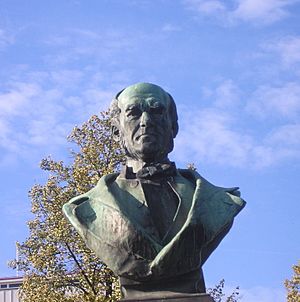Uno Cygnaeus facts for kids
Uno Cygnaeus was a very important Finnish educator and clergyman. He was born on October 12, 1810, in Hämeenlinna, Finland, and passed away on January 2, 1888, in Helsinki. Many people call him the "father of the Finnish public school system."
Cygnaeus did many great things for education. He started high-quality training for teachers. He also believed that education for women was very important. Most notably, he made crafts, known as sloyd (veisto in Finnish), a required subject in schools.
Contents
Early Life and Education
Uno Cygnaeus was born in Hämeenlinna, Finland. His father died when Uno was only eight years old. He went to the University of Turku to study natural sciences and theology. When the university moved, he continued his studies in Helsinki.
In 1837, he became a priest. He worked in Viipuri until 1839. There, he was an assistant pastor, a prison chaplain, and a teacher at a private school. These experiences, along with studying the ideas of famous educators like Johann Heinrich Pestalozzi and Friedrich Fröbel, helped Cygnaeus create his own ideas about teaching. Later, he worked for twelve years as a superintendent for a Finnish parish school in St. Petersburg.
Building the School System
In 1855, Tsar Alexander II became the ruler. He asked the Russian senate to improve Finland's education system. Uno Cygnaeus sent his ideas, and the senate liked them. He was chosen to create a new public school system for Finland.
To learn more, Cygnaeus traveled to Sweden, Denmark, Germany, and Switzerland. He was especially impressed by kindergartens in Hamburg and the Swiss school system. He took many notes during his travels. Based on these notes, he created a plan, which the senate approved in 1861.
Cygnaeus believed that schools should not be controlled by the church. He also wanted to set up a special college to train teachers. His plan became the foundation for the public school rules, which were set in 1866.
The Importance of Sloyd
The sloyd system became a required subject for boys in all rural schools in Finland. It was also required for all male teachers in training schools. Students learned about metals and how to make things. They also learned how to choose the right wood from forests. They understood how to care for materials and work together on projects.
A few years later, Sweden also adopted these ideas. A sloyd training school was opened in Nääs, Sweden, in the 1870s by Otto Salomon. Thousands of teachers from all over the world came to Nääs to learn. Sloyd was successfully introduced in many countries, including the UK, the US, Japan, Brazil, Argentina, Cuba, and other Scandinavian countries. Today, sloyd is still a required school subject in Finland, Sweden, and Norway.
Cygnaeus's influence even reached the United States. A teacher named Larsson, who was trained by Otto Salomon, moved to the U.S. in 1888. He started the Boston Sloyd School. This school is still seen as an important step in American technology education. The ideas of American educator John Dewey were also influenced by the sloyd movement that Cygnaeus started.
In Finland, general education still includes educative handicraft (käsityö) as a school subject. It is divided into two parts: textile work (tekstiilityö) and technical work (tekninen työ). These are taught as required subjects starting from the third grade. Students can choose either technical work or textile work.
From 1863 to 1869, Cygnaeus was the chief inspector of Finland's school system. He also directed a Finnish seminary in Jyväskylä. After that, he returned to his full-time job as chief inspector. From 1870 to 1887, he was also a member of the supreme board of education.
Death
Uno Cygnaeus passed away on January 2, 1888, in Helsinki, Finland.
Family
His cousin, Fredrik Cygnaeus, was a poet who wrote in Swedish.
Images for kids
See also
 In Spanish: Uno Cygnaeus para niños
In Spanish: Uno Cygnaeus para niños



